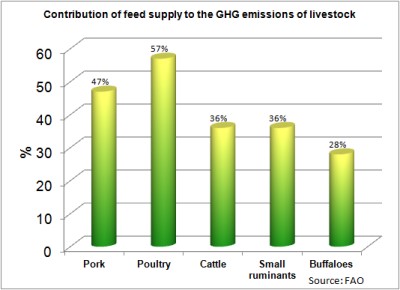Impact of feed supply chain on environment
By Harinder Makkar, FAO, Rome
Globally, the production, processing and transport of feed account for about 45% of the green house gas (GHG) emission from livestock sector. At a species level, feed production constitutes 47% and 57% of emissions from pork and chicken supply chains, respectively. For cattle, small ruminants and buffalo, feed production contributes 36%, 36% and 28% of the total emissions respectively. For ruminants these values are relatively smaller because enteric methane comprises the dominant fraction of total emissions.
 Fossil carbon dioxide and nitrous oxide are the dominant GHG in animal feed production. A substantial amounts of nitrous oxide is generated through the fertilization of feed crops and deposition of manure on pastures, representing together about 50% of feed emissions which is about 25% of the livestock sector’s total emissions. While the use of fossil fuels, for example diesel in machinery and tractors, oil in dryers and natural gas in the manufacture of mineral fertiliser nitrogen are the main sources of carbon dioxide. In the post-farm stages, carbon dioxide is emitted in various feed processes, associated with processing, mixing, and distribution of feed ingredients.
Fossil carbon dioxide and nitrous oxide are the dominant GHG in animal feed production. A substantial amounts of nitrous oxide is generated through the fertilization of feed crops and deposition of manure on pastures, representing together about 50% of feed emissions which is about 25% of the livestock sector’s total emissions. While the use of fossil fuels, for example diesel in machinery and tractors, oil in dryers and natural gas in the manufacture of mineral fertiliser nitrogen are the main sources of carbon dioxide. In the post-farm stages, carbon dioxide is emitted in various feed processes, associated with processing, mixing, and distribution of feed ingredients.
Among feed materials, grass and other fresh roughages account for about 50% of the emissions, mostly from manure deposition on pasture and land-use change. Crops produced for feed account for an additional quarter of emissions, and all other feed materials (crop by-products, crop residues, fish meal and supplements) for the remaining quarter.
Global croplands for feed and pasture areas have expanded in recent decades, accompanied by large increases in inputs such as energy, water, and fertilizer consumption. Land use and land-use change are an important source of greenhouse gases emissions globally in animal feed production. About 25% of feed emissions (about 9% of the livestock sector’s emissions) are related to land-use change. Land use for animal feed production can also be positive for the carbon balance since in these cases the soil acts as a carbon sink, as opposed to being a source of emissions e.g. with deforestation. Permanent, well-managed grassland are the land use in agriculture that has the highest potential to function as a carbon sink.
Sources: FAO studies

